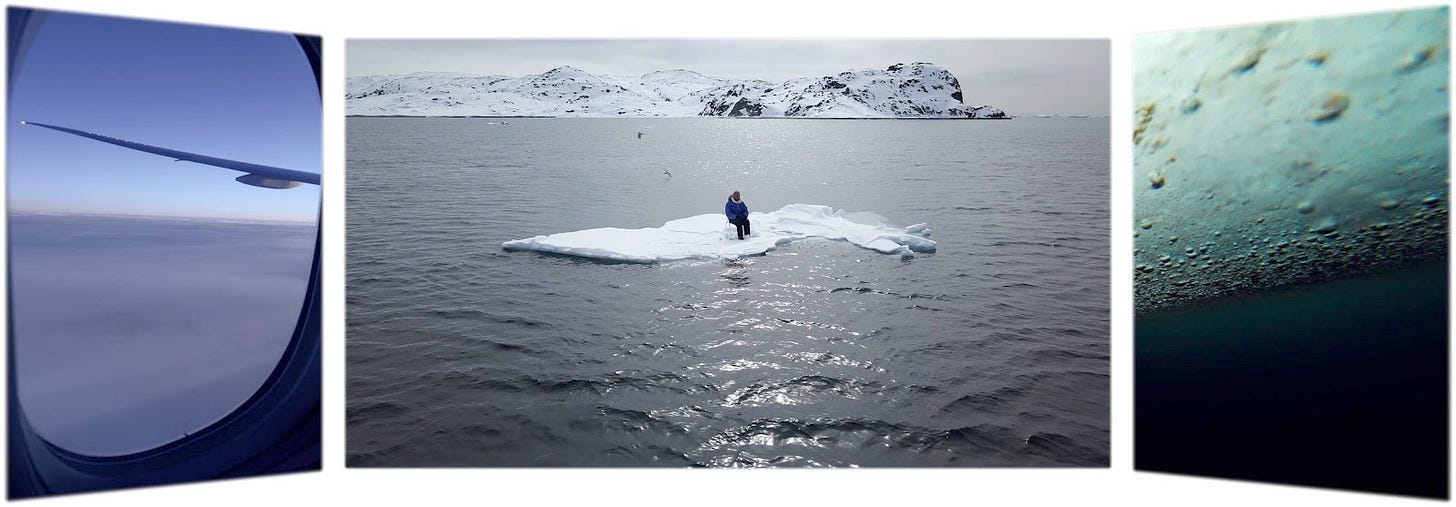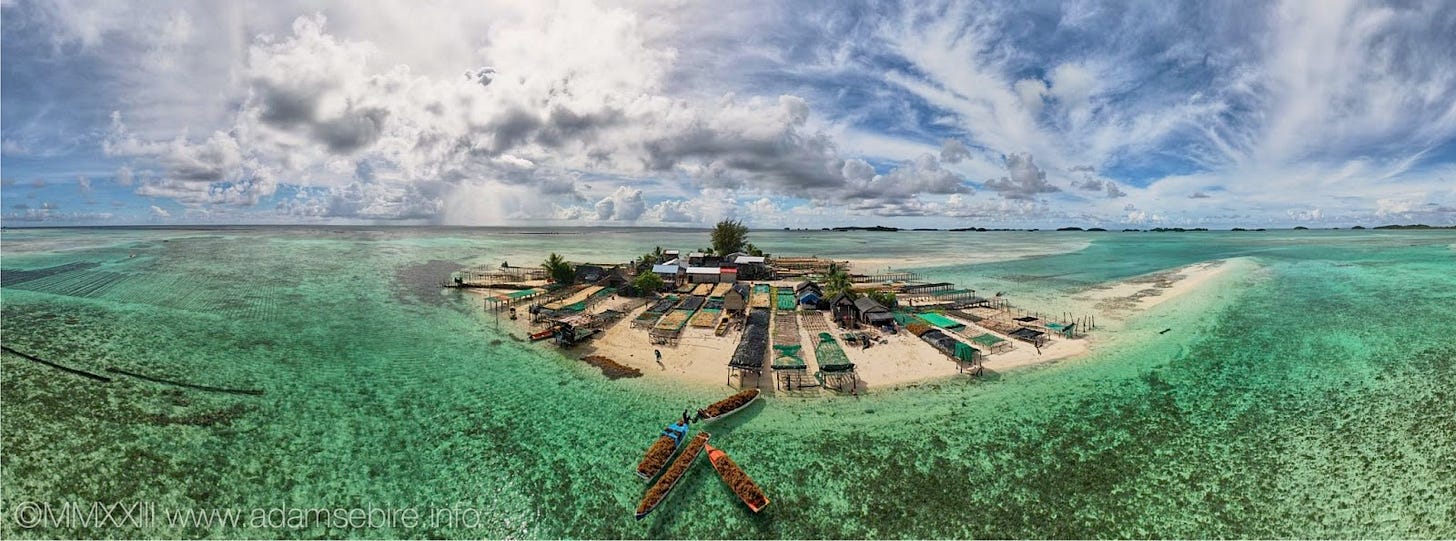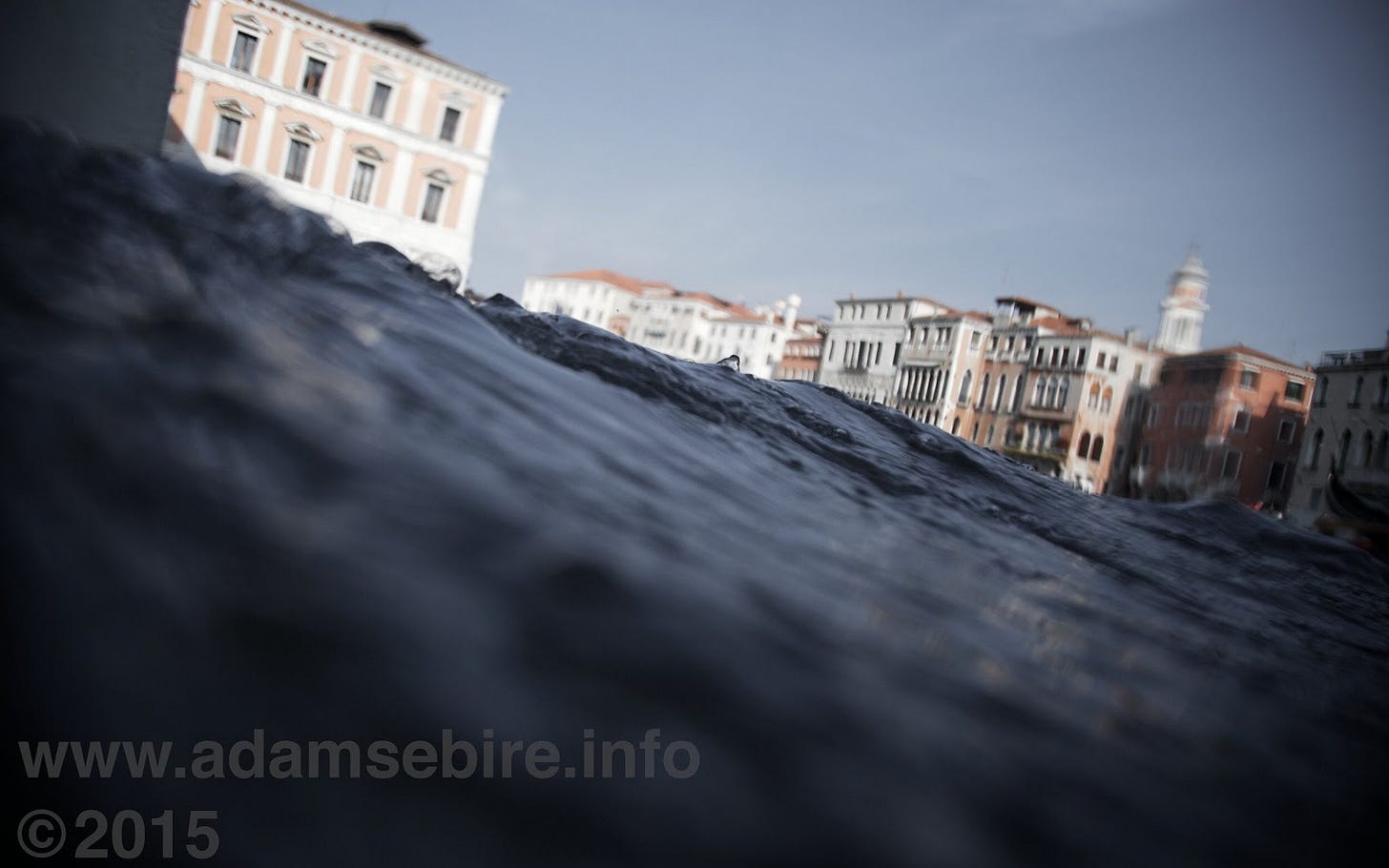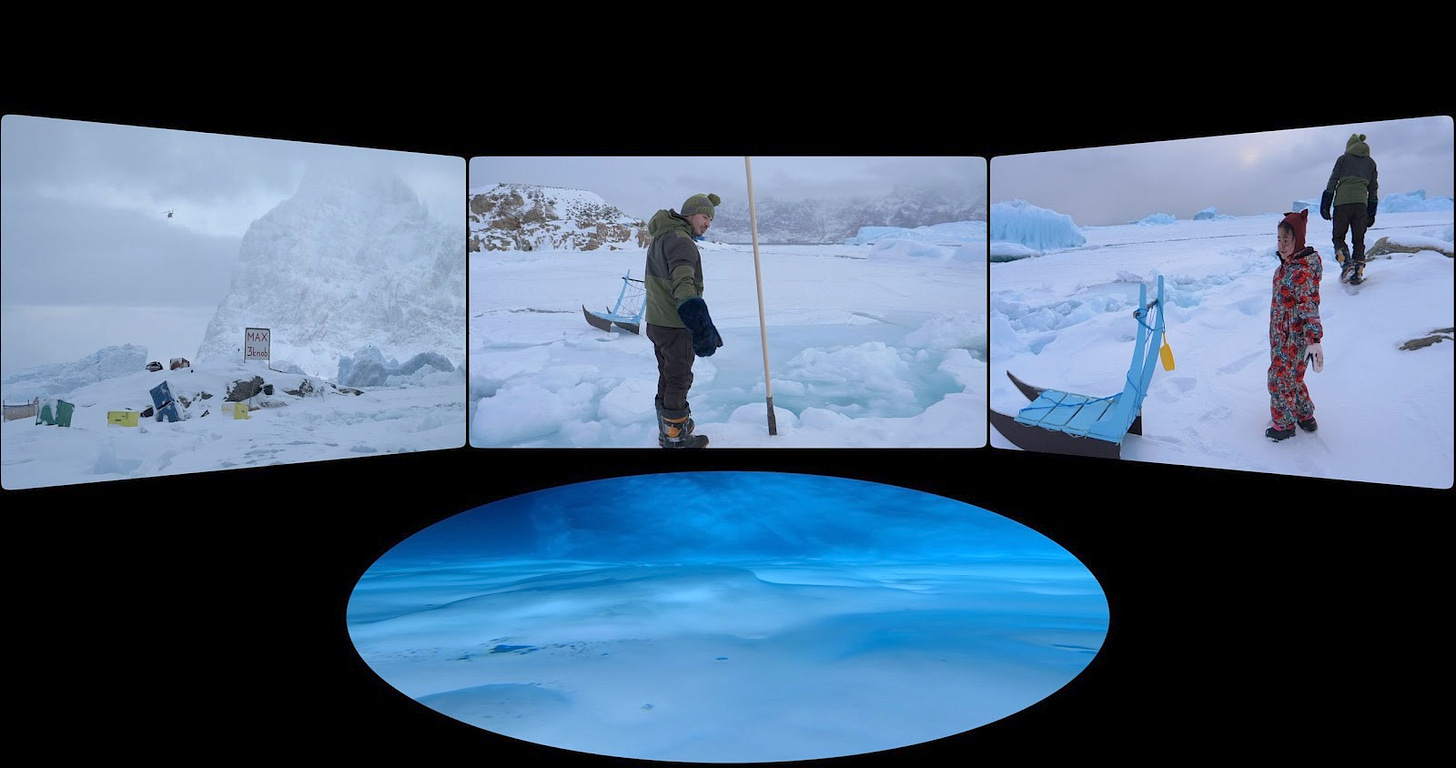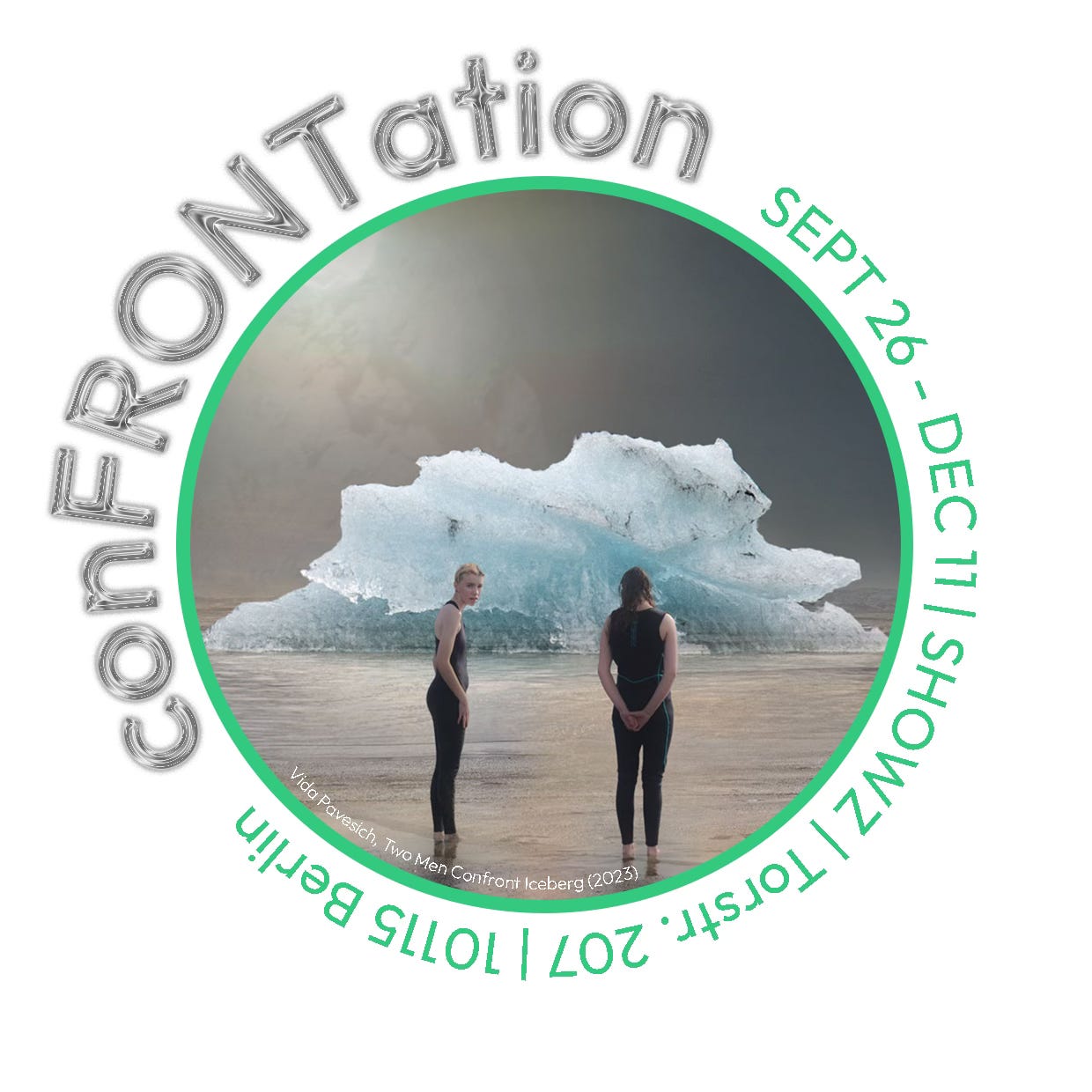As part of our new exhibition, conFRONTation, a storefront exhibition in Berlin Mitte, we showed Adam Sébire's artwork anthropoScene IV: Adrift (∆Asea-ice). In a conversation with the artist, we explored his connection to climate change, his life in the Arctic, and his work.
CAC: What is your Climate Change Story: Could you share your journey in understanding climate change and when you started creating climate art?
Adam: Back in 2003 – so 20 years ago – I went to Tuvalu to make a documentary. It's the second smallest country in the world, about two metres above sea level in the South Pacific.
I was there because a colleague of mine, when asked where she was born, told me, “well you’ve probably never heard of it and it’s not going to be around in 50 years anyway!“ As well as piquing my interest that was the moment when I realised entire countries are going to disappear and it was a catalyst for me. So the idea was to film the early visible evidence of climate change there, but it was really hard to do at that time because it wasn’t easily visible; it relied a lot on locals’ memories of places combined with bits of scientific data.
Documentary, it does have a problem in that it relies on visible evidence. But art has kind of more latitude to sort of play with reality. So I began a master of Fine Arts to push that aspect and then - fast forward to November 2019 and I was again on small low lying island, Venice – I'm sure you’ve heard of that one (smiles) – on the night of its terrible flood disaster.
187 centimetres of floodwaters just ripped through Venice and I was the only person crazy enough to be trying to film it in front of San Marco. I really thought I was going to drown that night. Meanwhile back in Australia, places I knew and loved were brning in massive bushfires. So I think 2019 was the year that climate change really began to hit home for developed countries – that we weren’t somehow immune – and my work then started to become less about evidencing the problem and more about our relationship as humans to climate change and the Anthropocene epoch we’d now tipped ourselves into.
CAC: What inspired your focus on glaciers and ice melting for the “anthropoScene” series, especially as an Australian? And how did you end up in the Arctic Sea, as mentioned on your website?
Adam: The Arctic is very much the canary in the in the coal mine regarding climate. Antarctica too but of course it's much more inaccessible and there are fewer visual examples of human influence - whereas up here where I live in the Arctic, just north of me is Svalbard – and there you have this amazing confluence of cause and effect where working coal mines are dug underneath entire glaciers!
So it's really a crucible of how some humans – those of industrialised nations – have altered the Earth System. I arrived in Svalbard in January 2020 as part of my PhD research and to hold a solo exhibition there. Two days after that exhibition opened, the pandemic hit and everywhere locked down. Australia effectively closed its borders so I could not go home for 18 months and I became one of the four million human inhabitants of the Arctic.
And now I have a front row seat on climate change.
As you know the Arctic is warming two to four times faster than the rest of the planet, seven times faster in Svalbard actually, so there's a lot to show, visually, up there.
And as for my focus on snow and ice and glaciers - once the physical pain associated with filming in these kind of locations subsides and you get used to it, it's easy to fall in love with water in the frozen form, and yet it's disappearing before our eyes because we're pushing the Earth ever more towards becoming a hothouse.
CAC: What are the challenges and dangers you face when creating art in extreme environments?
Adam: Well, I don't want to overstate the dangers! The biggest problem was that I was woefully equipped. Without the right clothing you're freezing, you're in pain, you're slipping over. The equipment I had wasn't well suited to cold temperatures. My drone too: every time I got close to magnetic north – you’re only 1200 kilometres from the North Pole up there – it seemed to get lost and lose control. Then of course, there's the idea behind Adrift, this work of mine that you’re showing, which involves sitting on a disintegrating Greenland ice floe which was, perhaps in retrospect, a little bit reckless!
The survival suit I had on was supposed to give me two or three minutes to live if I fell into the water. I've been dropped there by a Inuit narwhal hunter. He didn't speak English; I didn't speak Greenlandic but I think he sort of promised to return. He disappeared off fishing behind some icebergs and I was just stuck on this disintegrating piece of ice – extremely nervous at the beginning – but then I sent up the drone to take some shots and it gave me this kind of out of body experience when I saw myself sitting on this tiny fragile floe of ice. It was quite transformative actually.
CAC: Could you tell us more about that (feeling)?
Adam: Well I’d flown there so I knew that those greenhouse gas emissions, because of this formula which I can talk about, they were going to be responsible for the death of this 15.69 square metres of sea ice. But this same ice was also the only thing saving me. There's a whole movement called Ecosexuality that's all about treating the Earth like a lover and suddenly I felt like – well, I wasn’t amorous for this piece of ice, but I really felt a strong emotional connection to it. It was a very strange feeling of being protected by something which I knew I was killing.
CAC: Could you talk about your creative process a bit more?
Adam: I was digging into the latest peer reviewed scientific papers, especially the ones that give us a bit more insight into what could happen if we don't take urgent action on climate change. Reading between the lines a lot of these papers give you the sense that the scientists would really like to give us stronger warnings, but they’re limited by the Scientific Method’s requirement that they dispassionately present the facts.
As an artist I was interested in pushing beyond the kind of logical conclusions that the scientists drew.
For example, in the work that CAC is showing, Adrift (ΔAseaice), having engraved the scientific equation in the sea ice, I then solve it for my own flight emissions, 5.23 tonnes of CO2e. I cut out the resulting 15.69 square metres of sea ice, and then float off atop this piece. So we see how much one return economy seat, flying Sydney, Australia to Upernavik, Greenland, is responsible for melting.
But I didn't want it just to be data visualisation - sometimes data visualisation leaves me a bit cold - for example I could never quite grasp this concept of 1 tonne of CO2. I know Australians are responsible for I think 15 tonnes of carbon emissions per person, per year. Germans I think, 9 tonnes of carbon. Both of these figures have come down a lot, but are still a lot compared to, say, a Bangladeshi person, who's responsible for one tonne of carbon annually, on average. But how to visualise it?
So these two sea ice professors, Dirk Notz and Julienne Stroeve, have developed this formula that allows you to calculate how much Arctic sea ice would be lost per tonne of CO2 that you emit.
And it’s important because the less white sea ice you have, the less sunlight gets reflected back into space, which means that polar oceans warm faster, which in turn melts more ice.
It's called a feedback loop and it can become a dangerous climate tipping point.
So that scientific formula I borrowed was not only a breakthrough in what’s called “climate change event attribution”, but also I think a breakthrough in climate change psychology, because it allowed us to really comprehend the damage we do to the environment.
5.23 tonnes of CO2 for one economy passenger’s journey sounds like a large figure, and it is, because jet aeroplanes are emitting this into the stratosphere, which is three times worse than emitting it at sea level. Most flight carbon calculators conveniently ignore this – so you need to find one, like Atmosfair, that accounts for what’s called “radiative forcing”. Flying’s pretty much the most destructive thing you can do, climate-wise, as an individual. And it’s 1% of the world’s population who are super-emitters responsible for 50% of aviation carbon emissions.
CAC: Have you noticed the impact on people, who see your art?
Adam: That’s difficult to say, because I am often not there to ask! But I love this idea of projecting on to, say a shop front window - too often it feels like in a gallery, you are just preaching to the converted. So it’s important to get these ideas and images out to a wider audience.
But it’s not like presenting evidence. Art works upon the dark recesses of the brain, I think. Maybe someone sees this and maybe it influences them to travel from Berlin to Amsterdam by train next time. But I don’t want people to get bogged down by obsessions with personal carbon footprints. We need to focus more on paving the way for systemic change. For example, why is international aviation fuel untaxed, but public land transport is taxed - which often makes it cheaper to fly? And I feel like we can open people’s minds to challenge these norms in our very carbon intensive society. I think that can be a contribution art can make.
Ultimately it’s very hard to quantify. One thing I can say (smiles), is that it has had an impact on me: I wanted to get a sense of the disconnects operating in my own psychology. Separating cause from effect; my actions here and now from the consequences elsewhere and elsewhen. It’s something that kind of kicks in now, every time I switch on the oven, buy plastic or drive a car or whatever. I start to think about the ultimate impact of these things.
CAC: Why did you choose the triptychon (triptych) format for Adrift?
Adam: If you look at the Renaissance masters like Hieronymus Bosch, they had very powerful ways in triptych paintings of linking time and space when dealing with a problem that was much bigger than the human mind could grasp. Theology was his subject but climate change is also such a problem - its spatiotemporal dimensions are bigger than we can really comprehend - and we are caught within it, so it's very hard to see it in its full perspective. Some philosophers call this a “hyperobject”. So you're trapped within a concept making it very hard to get an overview of it.
So in Adrift when I use the triptych, across these panels I am able to spread cause and effect: human time, geological time, invisible emissions, tangible impacts, sitting on the ice, sitting on a plane … and these dislocated ideas can be put together simultaneously across multiple screens.
CAC: Is there maybe also a kind of religious connection?
Adam: Hah! This is dangerous territory to talk about, that science and climate change is kind of a religion.
I guess scientists would say - no it's a very rational problem, but the problem is of course that we don't act rationally upon the facts that they give us.
They just assume: okay here's the evidence, this is what you need to do to address the problem, now go and do it.
There's a missing piece and that's where art or perhaps a new religion could come in.
CAC: Have you learned from the (indigenous) people you worked with?
Adam: A lot of indigenous people are living on the front line of climate changes.
I think it puts you in your place, to go in to an indigenous community, conscious that you’ve come in as a part of the world that has overwhelmingly caused this problem – and yet you're seeing first hand how it’s dramatically affecting their very existence.
For the Inuit, it's a terrible situation, because the sea ice is so unreliable and unpredictable now - it’s too thin to safely be atop it on a dog sledge but you also can’t easily navigate a boat through it. So how do you feed yourself?
That was the subject of my last work, Sikujumaataarpoq, a West Greenlandic word meaning “sea ice is delayed”, and it bears witness to changes both for the people and also for the natural environment.
CAC: Moving beyond individual efforts, what political strategies do you think are crucial to prevent reaching the point of no return in combating climate change?
Adam: It’s sometimes said that the biggest impact individuals can have is not by recycling or switching cars or whatever but by voting for politicians who will treat the climate crisis like the emergency it truly is. In other words collective action.
But we also need actions that go beyond national boundaries. Greenhouse gases and extreme weather have no respect for our outdated obsession with these sort of national sovereignty ideas and I think the most effective strategies will be the ones that collaborate globally; that see everything through the lens of future generations, and that are based on climate justice: action based on knowledge that the causes and impacts of the climate crisis are not equally distributed.
We really need to find a more collaborative relationship with planetary systems, living within limits of a finite world. And maybe, at least I hope, art can help us find these new ways of thinking.
CAC: Thank you Adam!
more about the Artist:
https://www.adamsebire.info
conFRONTations is an avant-garde exhibition format in Berlin that critically addresses climate change within the unique context of storefront displays. These storefronts, often overlooked in the daily hustle and bustle by the general populace, mirror the frequent disregard of pressing climate issues. This exhibit challenges the passive stance of the public by showcasing interdisciplinary artworks dealing with climate change, urging individuals to pause and deeply engage with the subject




